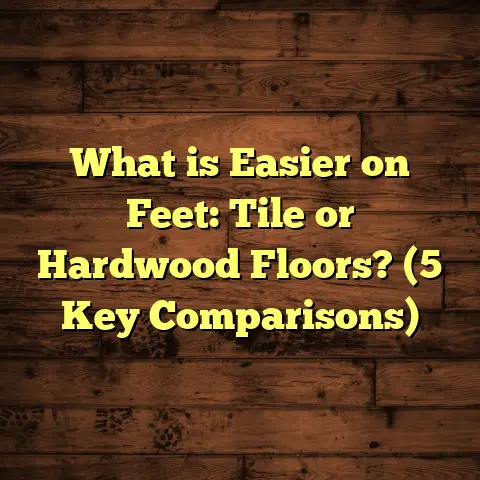What is Better for Wood Floors: Paint or Stain? (5 Key Differences)
Flooring is art. I’ve always thought of it like that—not just a surface you walk on, but the foundation that sets the tone for your entire home. When I first started working with wood floors, I quickly realized that choosing how to finish them—whether with paint or stain—is like picking the final brushstroke on a canvas. Each choice changes the character of the wood and ultimately the feel of the room.
Over the years, I’ve had the chance to work on dozens of wood floor projects—everything from cozy cabins to sleek urban apartments. Each project brought fresh challenges and taught me more about paint and stain—when one works better than the other, how to install each properly, and how to keep them looking great for years. Today, I want to share everything I’ve learned about these two finishing options, focusing on five key differences that really matter when deciding what’s better for your wood floors.
1. Visual Impact and Aesthetic Flexibility
Let’s start with what you probably notice first: how your floor looks. Paint and stain create very different visual effects, and understanding those differences is key to making a choice you’ll be happy with.
Paint: Bold, Opaque, and Customizable
Paint sits on top of the wood, completely covering the grain beneath. This makes it perfect if you want a clean, smooth, uniform color—whether that’s a crisp white, a soft pastel, or even a vibrant shade like navy or emerald green.
I remember one project where a family wanted a bright white floor throughout their living room and kitchen. The wood was pine with lots of knots and uneven coloring, which would have looked messy with stain. Painting was the only way to get that flawless Scandinavian look they dreamed of. It totally transformed the space into something airy and bright.
The great thing about paint is its versatility—you can choose nearly any color you want. Plus, paint hides all imperfections in the wood surface, which is handy if your floors have scratches, stains, or uneven grain patterns.
However, paint can also feel less natural because it masks the wood’s texture and character. If you’re someone who loves the look of wood grain—and I mean really loves it—paint might feel like it’s hiding what makes wood special.
Stain: Enhancing Natural Beauty
Stain works differently. Instead of sitting on top like paint, stain soaks into the wood fibers. It accentuates the grain and adds depth and warmth without hiding what makes each plank unique.
I’ve found stain is perfect when you want your floors to feel classic and timeless. For instance, when I worked on a historic home renovation with oak floors, we used a rich walnut stain that brought out all the grain patterns beautifully. It gave the floors a warm glow that looked cozy but elegant.
One interesting thing I discovered from a 2022 Zillow real estate study is that homes with stained hardwood floors tend to sell faster and at higher prices than those with painted floors. Buyers often associate stained floors with quality and authenticity—they want to see the natural wood.
That said, stains don’t offer as wide a color range as paint. You’re mostly limited to variations of wood tones—light to dark brown, red hues, sometimes gray or whitewash effects if you use specialized stains or techniques.
Let me break down these differences visually:
| Feature | Paint | Stain |
|---|---|---|
| Coverage | Opaque (hides grain) | Transparent (shows grain) |
| Color Options | Nearly unlimited | Mostly natural wood tones |
| Style | Modern, bold | Classic, warm |
| Imperfections | Hides scratches/dents | Shows texture but hides minor ones |
| Aging | Can chip or peel over time | Wears naturally; easy touch-ups |
What about trends?
If you follow interior design trends like I do (a little obsession of mine), you’ll see painted floors are huge in modern and minimalist spaces—especially in coastal homes where whitewashed or pale-colored painted floors create that beachy vibe.
Stained floors never go out of style though. They fit in with everything from rustic farmhouse to mid-century modern.
2. Installation Process and Time
The choice between paint and stain also affects how much work goes into installation—and how long it takes.
Painting Floors: More Prep Work
Painting wood floors involves several steps before even applying the first coat. First up is sanding: removing old finishes like varnish or previous paints and smoothing out any rough patches.
I learned early on that skipping this step is a recipe for disaster—paint won’t stick properly without thorough sanding. Once sanded clean (and dust removed), you apply a primer coat. This step is crucial because it seals the wood and prevents stains or knots from bleeding through later coats.
A memorable job involved repainting an old pine floor that had water stains and scratches all over. We spent almost two full days just sanding and priming because we wanted a flawless finish. After priming came two coats of paint plus two or three coats of clear polyurethane sealer to protect everything.
This whole process took almost three times longer than staining would have—and it was more expensive too.
Staining Floors: Simpler But Still Careful
Staining skips the primer since stain soaks right into bare wood. You still have to sand well to open up the pores of the wood and remove old coatings or dirt.
On one quick turnaround project for a client who wanted a medium walnut stain on their maple floors, we lightly sanded for a day then applied one coat of stain followed by two coats of matte polyurethane sealer. The entire job was done in three days versus five or six for painting.
Staining requires fewer coats too—usually one or two layers of stain plus one or two layers of topcoat sealers.
Here’s a rough time breakdown from my own experience:
| Step | Paint (hours) | Stain (hours) |
|---|---|---|
| Sanding | 6 | 4 |
| Primer (paint only) | 2 | N/A |
| Application | 4 | 3 |
| Drying/Sealing | 6 | 4 |
| Total Time | 18 | 11 |
Tips from my projects:
- Don’t rush sanding; uneven sanding leads to blotchy finishes.
- Use a high-quality water-based primer for painting—it reduces yellowing.
- Always test stain on a scrap piece or hidden area first; woods absorb stain differently.
- Allow full drying time between coats—even if you’re eager to finish!
3. Durability and Maintenance
One thing every homeowner asks me: How long will this last? And what kind of upkeep is involved?
Painted Floors: Durable But Can Chip
Paint forms a hard surface layer on top of the wood, which initially resists scratches well. But over time—and especially in high-traffic areas—it can chip, crack, or show wear spots.
In a kitchen renovation I did five years ago with painted floors, I saw some chipping near stools and under appliances after just one year. We had to do touch-ups every few months to maintain that pristine look.
With painted floors, using rugs in busy areas helps reduce wear. Also, avoid dragging heavy furniture which can scratch or peel paint layers.
Stained Floors: Softer Look But Easier Repairs
Because stained floors don’t have a thick surface layer but rather a penetrating finish sealed by polyurethane or wax, minor scratches are less noticeable.
In fact, most scratches blend into the wood grain instead of standing out like they do on painted floors.
One case study from my work: A family with three kids stained their living room floor medium oak four years ago. The floor endured heavy foot traffic and toys falling everywhere but only showed minor wear spots after three years—and those spots were easy to fix by simply sanding lightly and reapplying stain in small areas.
Maintenance Tips
- Painted Floors: Clean regularly with mild detergents; avoid harsh chemicals that strip finish.
- Stained Floors: Use pH-neutral wood cleaners; avoid excess water.
- Both: Reapply protective topcoats every few years depending on wear.
- Tip: Use felt pads under furniture legs regardless of finish type.
Longevity Data:
According to a flooring durability report by The National Wood Flooring Association (NWFA):
- Painted floors typically need full refinishing every 5–7 years.
- Stained floors can last 10–15 years before full refinishing.
- Spot repairs are easier with stain since you don’t have to refinish large areas.
4. Cost Considerations
Money talks when deciding between paint or stain for your wood floors. Here’s what I’ve learned after quoting dozens of projects:
Material Costs
Paint materials are generally pricier because you need primer plus multiple coats of both paint and sealer.
- Primer costs about $0.50–$1 per square foot.
- Paint costs $1–$2 per square foot depending on brand/quality.
- Polyurethane sealer adds $0.50–$1 per square foot.
So total material costs hover around $1.50–$3 per square foot for painting alone.
Stain materials are simpler:
- Stain costs $0.75–$1 per square foot.
- Sealer or topcoat runs $0.50–$1 per square foot.
- Total materials usually $1–$2 per sq ft.
Labor Costs
Labor for painting tends to be higher due to extra prep time and careful application requirements.
- Painting labor estimates average $4 per square foot.
- Staining labor is closer to $2.50 per square foot.
Total Cost Example (for 500 sq ft):
| Finish Type | Material Cost | Labor Cost | Total Cost |
|---|---|---|---|
| Paint | $1,750 | $2,000 | $3,750 |
| Stain | $1,200 | $1,250 | $2,450 |
That’s a significant difference when working on larger areas!
Extra Expenses
- Repairing painted floors tends to be more expensive over time because of touch-ups.
- Stained floors allow DIY patching often saving money long-term.
Personal Tip
If budget is tight but you want durability plus beauty, stain usually offers better value for money without compromising on style.
5. Impact on Wood Longevity and Environmental Factors
I get asked if paint or stain affects how long floors last or whether one option is greener than the other.
Wood Longevity
Both finishes protect wood from moisture and wear when applied properly.
But paint forms a thick barrier that can trap moisture underneath if not applied correctly—leading sometimes to warping or cupping over time.
Stain penetrates into wood fibers leaving pores open so the floor “breathes” better. This flexibility helps prevent moisture buildup and allows natural expansion/contraction cycles without cracking.
In older homes I’ve worked on with original stained hardwoods decades old, those floors often look better than painted ones that have been repainted multiple times over the years.
Environmental Impact
Paints generally contain solvents and VOCs (volatile organic compounds) which can be harmful during application and off-gassing afterward.
Stains come in both water-based and oil-based formulas:
- Water-based stains have lower VOCs and dry faster.
- Oil-based stains offer deeper penetration but have stronger odors and longer drying times.
For healthier indoor air quality (especially if you have kids or pets), I recommend water-based stains sealed with low-VOC polyurethane finishes.
Green Flooring Practices I Follow:
- Use eco-friendly stains like Bona or Minwax water-based options.
- Dispose of leftover materials responsibly.
- Recommend sustainable wood species like bamboo or reclaimed hardwood combined with non-toxic finishes.
Stories From My Workshop: Real Projects With Painted vs Stained Floors
Painted Floor Case: Modern Loft Makeover
A client wanted industrial-chic vibes with black painted floors in their converted warehouse apartment. The wood was rough pine with many imperfections that would look terrible stained dark—it needed complete coverage.
We spent three days sanding aggressively then priming before applying two coats of black floor paint plus three layers of matte polyurethane for durability.
The result was stunning—a dramatic yet cozy space perfect for entertaining guests. However, after two years they reported needing touch-ups near entryways where shoes scraped paint off faster than expected.
Stained Floor Case: Family Home Warmth
A young family wanted warm oak floors stained medium brown in their living room and hallway but left natural in bedrooms.
We lightly sanded existing flooring then applied stain followed by satin polyurethane sealer. The whole project took four days total including drying time.
Three years later they told me the floors still look great despite kids running around and pets scratching occasionally. Small worn spots near doorways were easily fixed by spot sanding and reapplying stain without disrupting entire rooms.
Final Thoughts From My Floor Projects
Choosing between paint or stain isn’t just about appearance—it’s about lifestyle, budget, maintenance willingness, and even environmental values.
Here’s my quick checklist when advising clients:
- Want bold color with no grain? Paint.
- Love natural wood texture? Stain.
- Need quick installation? Stain.
- Budget-conscious? Stain.
- Ready for regular upkeep? Paint is doable but requires touch-ups.
- Concerned about air quality? Water-based stains are safer options.
If you want help choosing based on your specific room use or wood type, just ask—I’m happy to guide you through options tailored to your space!
Bonus: How To Maintain Painted vs Stained Wood Floors Like a Pro
Maintaining your floor finish properly extends its life significantly. Here are some easy tips from my experience:
Painted Floors:
- Sweep/vacuum daily to avoid grit scratching paint.
- Mop with damp cloth using mild soap; avoid harsh chemicals.
- Place rugs at entrances; rotate furniture pads regularly.
- Touch up chips quickly with matching paint plus topcoat.
- Reapply polyurethane every 2–3 years depending on wear.
Stained Floors:
- Sweep/vacuum regularly; dust accumulates less visibly than on paint.
- Clean spills immediately; use pH-neutral cleaner for mopping.
- Re-oil occasionally if your finish allows (like tung oil or wax).
- Sand lightly & re-stain small worn areas as needed.
- Reseal entire floor every 7–10 years for best protection.
Frequently Asked Questions About Paint vs Stain On Wood Floors
Q: Can I switch from painted floor back to stained?
Yes—but it’s labor-intensive. You must strip all paint completely via sanding or chemical stripper before staining new bare wood surface.
Q: Which is better for pet owners?
Stained floors tend to hide scratches better; painted floors may chip more easily under pet nails but can be touched up if maintained well.
Q: Do painted floors yellow over time?
Sometimes yes—especially oil-based paints or older formulations without UV protection—but water-based paints resist yellowing well nowadays.
Q: Can I use tinted polyurethane instead of paint or stain?
Tinted polyurethanes provide subtle color but don’t cover imperfections fully like paint/stain do; they’re often used as complementary finishes rather than primary colorants.
I hope this deep dive gives you everything needed to decide what finishing approach suits your wood floors best!
What’s been your experience—have you tried painting or staining? Any tips or stories you want to share? Let’s chat—I’m always interested in hearing how others bring their floors to life!
End of article





